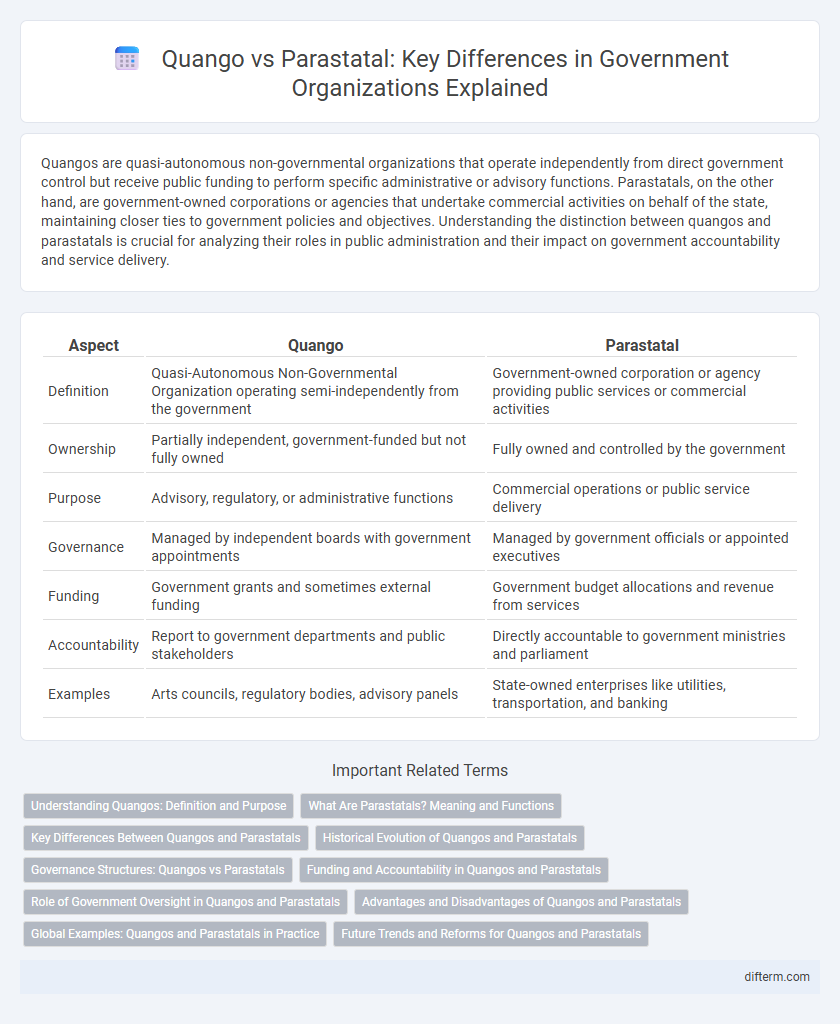Quangos are quasi-autonomous non-governmental organizations that operate independently from direct government control but receive public funding to perform specific administrative or advisory functions. Parastatals, on the other hand, are government-owned corporations or agencies that undertake commercial activities on behalf of the state, maintaining closer ties to government policies and objectives. Understanding the distinction between quangos and parastatals is crucial for analyzing their roles in public administration and their impact on government accountability and service delivery.
Table of Comparison
| Aspect | Quango | Parastatal |
|---|---|---|
| Definition | Quasi-Autonomous Non-Governmental Organization operating semi-independently from the government | Government-owned corporation or agency providing public services or commercial activities |
| Ownership | Partially independent, government-funded but not fully owned | Fully owned and controlled by the government |
| Purpose | Advisory, regulatory, or administrative functions | Commercial operations or public service delivery |
| Governance | Managed by independent boards with government appointments | Managed by government officials or appointed executives |
| Funding | Government grants and sometimes external funding | Government budget allocations and revenue from services |
| Accountability | Report to government departments and public stakeholders | Directly accountable to government ministries and parliament |
| Examples | Arts councils, regulatory bodies, advisory panels | State-owned enterprises like utilities, transportation, and banking |
Understanding Quangos: Definition and Purpose
Quangos, or Quasi-Autonomous Non-Governmental Organizations, operate independently from direct government control while performing public functions, often funded by the government but managed by appointed boards. They serve to deliver specialized services or regulatory oversight without the political constraints faced by traditional government departments. Understanding their purpose clarifies their role in balancing public accountability with operational flexibility, contrasting with parastatals that are government-owned corporations engaging directly in commercial activities.
What Are Parastatals? Meaning and Functions
Parastatals are government-owned corporations or agencies established to undertake commercial activities on behalf of the state, often in sectors like utilities, transportation, and natural resources. They function to provide public services, promote economic development, and manage resources while operating with a degree of autonomy from direct government control. These entities balance public interest goals with commercial objectives, enabling efficient service delivery and investment in strategic industries.
Key Differences Between Quangos and Parastatals
Quangos (Quasi-Autonomous Non-Governmental Organizations) operate independently from direct government control but are funded by the government to deliver specific public services, while parastatals are government-owned corporations fully controlled and managed by the state. Quangos often have a regulatory or advisory role with limited commercial functions, whereas parastatals engage in commercial activities and generate revenue. The key distinctions lie in governance structure, autonomy level, funding sources, and operational focus within the public sector.
Historical Evolution of Quangos and Parastatals
Quangos (Quasi-Autonomous Non-Governmental Organizations) emerged in the mid-20th century as governments sought to delegate specific regulatory and administrative functions to semi-independent bodies, enhancing efficiency and reducing direct political control. Parastatals, rooted in the post-colonial development era, historically functioned as state-owned enterprises with significant economic roles, especially in sectors like infrastructure, natural resources, and public utilities. The historical evolution of quangos reflects a shift towards decentralization and specialized governance, while parastatals demonstrate a state-driven economic intervention model, both adapting to changing political and economic landscapes over time.
Governance Structures: Quangos vs Parastatals
Quangos (Quasi-Autonomous Non-Governmental Organizations) operate with greater independence from direct government control, featuring boards often appointed by ministers but functioning with autonomy in decision-making. Parastatals are government-owned corporations or agencies with stronger state oversight, typically aligning closely with public policy and government directives. The governance structure of quangos emphasizes flexibility and specialized expertise, while parastatals prioritize state accountability and public service delivery.
Funding and Accountability in Quangos and Parastatals
Quangos receive funding primarily through government grants and are subject to public sector financial controls, ensuring accountability via parliamentary oversight and audit processes. Parastatals operate with a mix of government funding and revenue from commercial activities, balancing financial independence with accountability to government ministries. Both entities are accountable to public stakeholders, but quangos typically adhere to stricter budgetary and reporting requirements due to direct government funding.
Role of Government Oversight in Quangos and Parastatals
Government oversight in quangos ensures autonomy while maintaining accountability through regulatory frameworks and performance reviews. Parastatals face direct government control with strategic management, budget approval, and policy compliance to align operations with public interests. Both entities emphasize transparency and efficiency, but quangos balance independence with oversight, whereas parastatals operate as government-controlled corporations.
Advantages and Disadvantages of Quangos and Parastatals
Quangos (Quasi-Autonomous Non-Governmental Organizations) offer greater flexibility and operational efficiency compared to traditional government bodies, allowing for specialized expertise and more responsive decision-making. However, they face criticism for reduced accountability and potential lack of transparency due to their semi-independent status. Parastatals, as government-owned corporations, ensure direct government control and alignment with public policy objectives but often suffer from bureaucratic inefficiencies and political interference that can hinder performance.
Global Examples: Quangos and Parastatals in Practice
Quangos, such as the UK's Arts Council England, operate independently from direct government control while receiving public funding to deliver specialized services. Parastatals like Brazil's Petrobras are state-owned enterprises tasked with commercial activities that serve national economic interests. Both structures exemplify different approaches to balancing government oversight and operational autonomy in public sector management worldwide.
Future Trends and Reforms for Quangos and Parastatals
Future trends in government reform increasingly emphasize enhancing transparency and accountability within Quangos and Parastatals through digital governance and performance-based frameworks. Reforms focus on restructuring these entities to improve efficiency, reduce duplication, and foster public-private partnerships, leveraging technology-driven data analytics for better service delivery. Emphasizing stakeholder engagement and regulatory oversight aims to balance autonomy with government control, ensuring alignment with evolving policy priorities and fiscal constraints.
Quango vs Parastatal Infographic

 difterm.com
difterm.com